My Astronomy Equipment
Or
My Bout With Aperture Fever
|
|

[click on thumbnails for larger images]
|
My First Telescope (Tycho)

|
|
 Meade
ETX-90/EC Astro Telescope. Meade
ETX-90/EC Astro Telescope.
This highly portable 90mm Maksutov-Cassegrain Reflector got me
started in this hobby. Because of its portability, Tycho is still the first
scope I grab for a quick lunar or planetary observation session.

Tycho is configured with:
|

Autostar Computer Controller |

Meade Deluxe Field Tripod |
|
|

Meade Electric Focuser |
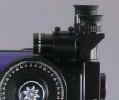
Meade 8X25mm Right-Angle Finder |
|
|

Dew Shield |

Rigel QuikFinder |
|

Some
Links |
|
|
My
Second Scope (Copernicus)

|
|
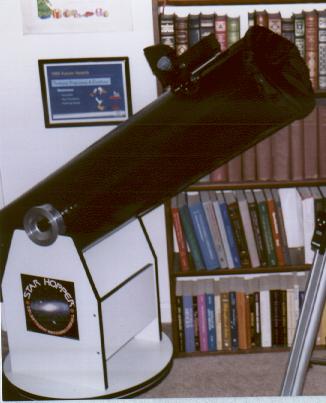 Celestron 8" Starhopper
Dobsonian. Celestron 8" Starhopper
Dobsonian.
Missing all the wiz bang computer control of the
ETX, Copernicus, an 8-inch Newtonian Reflector on a Dobsonian mount, is a basic
light-bucket providing enough aperture to go beyond planetary observation into
the realms of deeper space.

Copernicus is configured with:
|
|

Telrad Reflex Finder
|

Lasermax Laser/Holographic Collimator/p>
|
|

Some
Links |
|
|
My Newest Scope (Galileo)

|
|
 Celestron
CG-11 Celestron
CG-11
Couldn't resist picking up this behemoth at auction.
Galileo is a 11" Schmidt-Cassegrain
Reflector on a Losmandy German Equatorial Mount, by no stretch of the imagination a portable
scope, but the large aperture promises some thrilling deep-sky observations.
Unfortunately, its large aperture also make it extremely susceptible to
light pollution and so is most useful only under dark skies.

Galileo is configured with:
|

Losmandy G-11 German Equatorial Mount |

G-11
Tripod
|
|
|
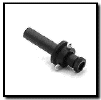
Celestron Polar Finder with Illuminator |

Telrad Finder |
|
|

Orion FlexiShield Dew Shield |
Celestron 7X50 Finderscope
|
|

Clutch knob set |
|

Some
Links |
|
|
My Binoculars
|
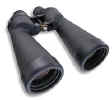 Fujinon
10x70 FMT-SX Polaris Fujinon
10x70 FMT-SX Polaris |
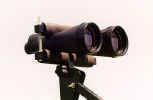 Virgo
Sure/Grip Binocular Holder Virgo
Sure/Grip Binocular Holder |
 Virgo
SkyMount Parallelogram Mount Virgo
SkyMount Parallelogram Mount |
 Bogen/Manfrotto
3001 Tripod Bogen/Manfrotto
3001 Tripod |
Binocular Specifications
| Magnification |
Objective
(mm) |
FOV |
Eye Relief
(mm) |
Exit Pupil
(mm) |
Max Width
(mm) |
Height
(mm) |
Weight
(kg) |
| 10x |
70 |
5°18' |
12 |
7.0 |
244 |
285 |
2.16 |
|
Accessories
|
Meade Eyepieces

|
Celestron Eyepieces

|
|
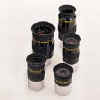
|

|
|
26mm LP Series 4000 Super Plossl
|
26mm Plossl
|
|
15mm Super Plossl |
25mm SMA Wide Angle |
|
9.7mm Super Plossl |
7.5mm Ultima Series |
|
5mm Ultima Series |
|
Orion Eyepieces

|
Scopetronix Eyepieces

|
|
Optilux 2" 50mm
(not yet in service) |
40mm Plossl |

|

Lasermax Laser/Holographic Collimator
|

TeleVue 8mm-24mm Zoom Eyepiece
|

Sky Atlas 2000.0 Star Charts
|
|
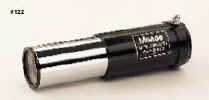 Meade
2X Telenegative Barlow Lens
|
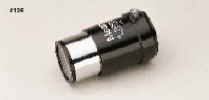
Meade 2X Short-Focus Barlow Lens
|

Nikon CollPix 990 Digital Camera
|

Orion Variable Tele-Extender |
Planned Purchases
|

450 LOMO Binocular Viewer
|

SkyWindow Binocular Mount
|
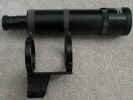
9X60 Finder with illuminated reticle (for Galilieo) |

2"
Diagonal
(to put my 2" Optilux 50mm in service - will undoubtedly spark
purchases of additional 2" eyepieces) |
|
Dew Management System (for Galileo) |
 |
Narrow-band HII Light Pollution Filter |
 |
#8 Yellow Filter |
 |
#23A Light Red Filter |
 |
#38A Deep Blue Filter |
 |
#56 Light Green Filter |
 |
#80A Light Blue Filter |
 |
#58 Green Filter |
 |
Variable Polarizing Filter |
|
|
And if I can talk my wife into it:
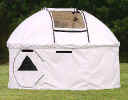
SkyTent Portable Observatory
|
The Power Myth
|
| When visitors see my telescopes they invariably ask the
question, "How much does it magnify?" or "What's its
power?" However, unlike fixed magnification binoculars, the power of
an astronomical telescope depends on the eyepiece being used. Power is a
function of the fixed focal length (the distance from the objective to the focal
point) of the telescope divided by the focal length of the eyepiece. The power
of such a telescope can be varied by exchanging the eyepiece. By using
increasingly smaller focal length eyepieces, the power of any telescope can be
increased almost indefinitely. However, "useable" power cannot
be increased without limit. As the size of the image increases with
increased magnification, the image becomes fainter and fuzzier. What is
important, therefore, is the resolution of the original unmagnified image.
This resolution is dependent on the light-gathering ability of the the telescope
which in turn is a function of its aperture (the diameter of its objective lens
or primary mirror). Contrary to the popular misconception therefore, the most
critical characteristic of an astronomical telescope is not its power or
magnification, but its aperture or light-gathering ability. |
Power Matrix
|
|
The following are rules of thumb for estimating Low, Medium and
High Power limits for a telescope of given aperture.
| Low Power |
.3 - .4 times the aperture in mm |
| Medium Power |
1.0 - 1.2 times the aperture in mm |
| High Power |
font face="verdana, Arial, Helvetica">2.0 - 2.5 times the aperture in mm |
NOTE: Magnification above 300X will only be useful under excellent
atmospheric conditions

Here are the power configurations for my telescopes and my current set of eyepieces.
| |
Tycho |
|
Copernicus |
|
Galileo |
|
Scope |
Meade ETX-90/EC |
Celestron 8" Dobsonian |
Celestron G-11
SCT |
|
Aperture |
90mm=3.5" |
203mm=8" |
279mm=11" |
| Focal Length |
1250mm |
1220mm |
2800mm |
| Maximum Magnification |
360X |
812X |
1116X |
| Useful Magnification |
180X |
406X |
558X |
| Low Power |
27X-36X |
61X-81X |
84X-112X |
| Medium Power |
90X-108X |
203X-244X |
279X-335X |
| High Power |
180X-225X |
406X-508X |
558X-698X |
|
|
Eyepieces |
Mag |
w/Barlow |
|
Mag |
w/Barlow |
|
Mag |
w/Barlow |
| 40mmfont> |
31X |
62X |
30X |
60X |
70X |
140X |
| 26mm |
48X |
96X |
47X |
94X |
108X |
215X |
| 25mm |
50X |
100X |
49X |
98X |
112X |
224X |
| 15mm |
83X |
167X |
81X |
163X |
187X |
373X |
| 9.7mm |
129X |
258X |
126X |
252X |
289X |
577X |
| 7.5mm |
167X |
333X |
163X |
325X |
373X |
747X |
| 5mm |
250X |
500X |
244X |
488X |
550X |
1120X |
|
|
Zoom Eyepiece |
Mag |
w/Barlow |
|
Mag |
w/Barlow |
|
Mag |
w/Barlow |
| 24mm |
52X |
104X |
51X |
102X |
117X |
233X |
| 16mm |
78X |
156X |
76X |
153X |
175X |
350X |
| 12mm |
104X |
208X |
102X |
203X |
233X |
467X |
| 8mm |
156X |
313X |
153X |
305X |
350X |
700X |
|
|
 The Pages of The Gray Wizard
The Pages of The Gray Wizard